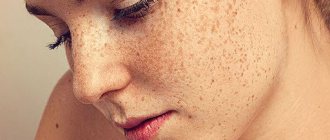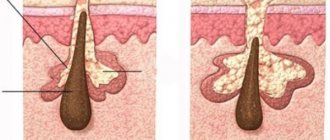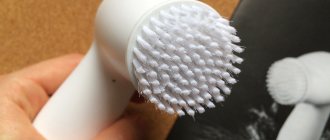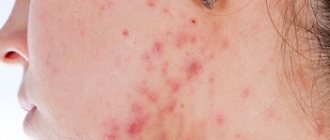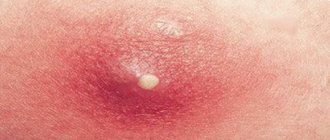The presence of a mole on the body can give a person charm or, conversely, ruin the first impression of him. This is especially true for moles located on the face. Not so long ago, in the last century, they were used as decoration (front sights). Today, world fashion dictates the opposite - the skin of the fair half of humanity should be smooth and clean. Of course, a mole can be removed. However, there are certain categories, especially on the face, that are strictly prohibited from undergoing surgery. They can only be disguised.
Are colorless moles on the body dangerous?
Any growths on the body are a pathology of the epidermis, and a natural phenomenon. Benign neoplasms do not cause trouble or problems to their owner. But under the influence of certain factors, it degenerates into a malignant form.
The nature of colorless moles that do not pose a threat to health can be determined by certain signs:
- the edges are smooth and clear;
- pliable, not rigid;
- absence of inflammatory processes around the growth;
- small size;
- do not protrude much above the surface.
In other cases, flesh-colored neoplasms indicate the presence of serious diseases, such as Vitiligo, Leukoplakia, Seborrhea.
A transparent mole occurs on the body in single and multiple cases. Colorless moles are localized mainly on the face, forehead, neck, head, chest, and armpits.
Several types of colorless neoplasms are noted.
| Form | View |
| Flat | A birthmark with a smooth surface. It looks like a skin spot that gradually discolors. |
| Warty | Neoplasms are formed from birth. Their size can reach 20 mm. They often focus on the nose and eyelid. |
| Hanging | Convex small growths can most often be observed on the neck. They do not cause inconvenience, they look like berries. |
Some colorless birthmarks are located in dangerous areas where they can easily be touched or injured. You need to handle them carefully so as not to cause degeneration into oncology.
What localization is best to remove moles?
If moles are localized in areas of constant friction in contact with clothing, in places with a risk of being cut off when shaving or torn off, it is necessary to consult a specialist doctor (dermatologist, oncologist, oncodermatologist) for treatment, to establish indications for removal, and to determine a method for eliminating the formations.
It is better to remove a light mole if it is located in the following areas of the body:
- on the face in men (daily trauma from shaving);
- on the neck or interclavicular area (friction when wearing jewelry, a scarf);
- in the armpits and intimate area (risk of shaving and injury);
- in the groin folds and on the lower back (friction by clothing);
- on the feet, palms with convex shapes;
- under the breasts in women, in places where bra straps rub;
- remove light moles that are constantly exposed to sunlight (on the face, shoulders, décolleté;
- with constant treatment with cosmetic substances, creams, alcohol lotions (especially on the face of women).
Reasons for appearance
Colorless moles do not appear spontaneously. One can always find a logical source for their origin.
Medical practice identifies several etiotropic factors that influence the formation of colorless growths:
- long-term exposure to aggressive ultraviolet rays;
- hormonal surges associated with pregnancy and puberty;
- chronic inflammatory disease of the sebaceous glands;
- invasive cosmetics;
- lack of vitamins and minerals;
- taking photosensitizing drugs;
- a symptom of calcium deficiency and vitamins B and E;
- mechanical damage to the epidermis;
- heredity;
- taking hormonal drugs.
Sometimes even bad habits can lead to the appearance of colorless growths. Therefore, you should reconsider your lifestyle.
Often, ordinary new growths can fade as the process of aging and death occurs. But if the area around them becomes lighter, you should urgently consult a doctor.
An important point is to independently or with the help of specialists determine the cause of the appearance of colorless neoplasms in order to prevent the development of others. This is especially true for women, since even a colorless mole on the body or face leads to a cosmetic defect.
Signs of colorless moles that need to be seen by a doctor
A benign flesh-colored mole does not often change into a threatening shape. Oncology can begin due to excessive production of melanocyte cells. The most common negative consequence is melanoma.
Serious signs of colorless neoplasms that require special attention include:
- the appearance of a white halo;
- if a small birthmark grows;
- presence of plaque on the surface;
- there was pain when touched;
- began to bleed;
- the presence of white inclusions;
- the mole has become discolored;
- It started to get dark.
If the corresponding symptoms are present, you should immediately consult a doctor. A specialist will carefully examine and find out how the colorless growth began to appear. A dermoscopic analysis is required, which shows whether the pigmented formation needs to be eliminated or not.
You should contact a dermatologist or surgeon if you develop new colorless birthmarks, as well as when modifying existing ones. Modern equipment allows you to track the dynamics of the development of a mole and measure the level of pigment. The specialist will determine the nature of the tumor and, if necessary, prescribe therapy.
A person who is at risk needs to be careful on the beach and avoid mechanical injuries.
Features of removing colorless moles
Almost a third of skin cancer arises from degenerated growths. The diagnosis can only be made by a doctor. However, you need to pay more attention to the color change. And if the tumor turns black, this signals that the tumor cells begin to divide chaotically and produce the pigment melanin. But there are colorless melanomas, which even for a specialist are difficult to distinguish from benign skin pathologies.
Many people are afraid to get rid of colorless birthmarks, thinking that they will harm themselves. There are a number of moles, so-called special multiple dysplastic growths. They must be removed for preventive purposes. They have a very high risk of degenerating into a malignant form.
Colorless growths should be removed only in specialized institutions. Having taken genetic material for research, the doctor determines whether the operation can be performed and what is the best way to do it.
Modern medicine offers different options for implementing this process. Colorless neoplasms are excised, as are pigmented birthmarks.
| Type of operation | Description |
| Surgical method | The manipulation is performed under local anesthesia. This is a popular method that is used to excise large growths. However, this method can remove all moles, regardless of the depth of germination. At the end of the operation, cosmetic stitches are applied. After a week they are removed. Light scars remain. |
| Electrocoagulation | The session begins with disinfection of the birthmark area. The operation is performed with special equipment using an electrocoagulator under local anesthesia. The tissue is being cauterized by electric current. The electrode heats up and burns out the tumor. After the operation, a crust remains, which protects the wound from infection and bleeding. |
| Chemical destruction | The destructive effect is caused by chemicals such as solcoderm, cantharidin, salicylic, and lactic acid. The substance is applied to the growth. After a few days, a dry crust forms, which then falls off. The wound heals in 30 days. |
| Cryodestruction | Freezing pathological tissues with liquid nitrogen. Under the influence of low temperature, the blood supply to the birthmark is disrupted, which leads to the destruction of the affected tissue. This operation occurs quickly and without pain. |
| Laser method | The operation involves directing a laser beam at the tumor. A layer-by-layer removal of the skin area on the birthmark occurs. After 14 days, complete healing of the wound occurs, leaving no trace. |
| Radio wave surgery | A non-contact method where high-frequency waves of thermal energy cut tissues and remove pigmented cells. |
All methods do not require hospitalization. But after the operation, preventive measures should be taken.
How to make a mole
Instructions
Previously, moles were painted or cut out of fabric and glued. Now everything is much simpler. A mole made with permanent makeup looks much more natural and impressive. Such a mole will look very natural, like a real one, and it will last you for many years.
In order to make an artificial mole, you need to go to a permanent makeup specialist or to a tattoo parlor. A qualified specialist will do everything at the highest level - you can’t tell it from a real one. When you come to a specialist to make a mole for yourself, he will ask you what shape it should be, in what place, what color and size.
Now an anesthetic composition is applied to the site of the future mole if the area where the mole is applied is very sensitive.
Next, from the center, the master begins to drive the coloring composition into the skin. This is done in a spiral until the mole reaches the desired size.
At the end of the tattoo, an anesthetic is applied to the new mole.
At home, you need to smear the new mole with Actovegin in the morning and evening. When the primary crust comes off, you can stop smearing the mole with Actovegin. The secondary crust will come off in a couple of weeks and you will be able to enjoy the final appearance of your mole.
Video on the topic
note
You can hide a small scar with a fly, but under no circumstances should you correct a real mole using permanent makeup or tattooing. This can lead to serious consequences: very severe inflammation or cancer.
www.kakprosto.ru
Is it possible to bleach a mole yourself?
Many women are concerned about the question of how to discolor a mole on their face. Some try to whiten using traditional cosmetology recipes. Several methods are used to lighten birthmarks. All of them are based on the application of lotions soaked in certain products, such as:
- lemon juice;
- tomato juice;
- olive oil;
- vitamin A;
- vitamin E;
- Apple vinegar;
- iodine;
- oats with milk and rice flour.
To make moles lighter, it is recommended to spend less time in the sun and use sunscreen.
Any independent manipulation of birthmarks is very risky. It is necessary to monitor moles and, if they transform, urgently contact a dermatologist.
How are facial nevi classified?
Moles on the face are of the following types:
| Moles on the face | Symptoms |
| Flat nevi | These can be either large moles or fairly inconspicuous ones. The reason for their occurrence is the already mentioned accumulation of melanocytes in the upper layer of the skin. Such nevi do not pose a danger due to the almost complete lack of reaction to ultraviolet rays and the tendency to grow. |
| Hemangiomas | For the most part, these are extensive red moles that are vascular in nature. They originate on the surface of the facial skin and may look like nodules or hanging nevi. The reason is the pathology of vascular development. |
| Angiomas | Such red moles usually appear at the capillary level; their material is blood vessels. The appearance of such formations on the face is typical mainly for people who have disturbances in the functioning of the pancreas. |
| Convex | Such a mole can be found on the face quite often. Externally, it is characterized by the absence of bright pigment, so its color is comparable to facial skin. Another characteristic sign is the presence of a hair growing from the nevus (in both men and women). The appearance of such a formation begins in the deep layers of the skin. On the outside it has a bumpy or smooth surface. If a mole exceeds 1 cm in diameter, there is a suspicion that it is malignant. |
| Blue nevi | These can be both large and miniature in size, the color of which varies from light blue to dark blue shades. All of them have a basically smooth and dense structure, rising above the skin in the form of a hemisphere. |
Pigment spots are considered separately from moles. They are predominantly gray or brown in color and can actively grow and darken over time, even turning black.
Moles are divided according to the following parameters:
- depth of location in the skin;
- by type;
- form;
- size;
- coloring;
- and dangers.
In appearance, such neoplasms can be:
- flat;
- convex;
- round or oval with a smooth or rough surface.
vary in color:
- from light to various shades of brown;
- from blue to blue;
- from red to purple.
Sizes vary from millimeter to very large. Most moles are harmless, and they never develop into cancerous tumors.
However, among them there may also be basal cell carcinomas - these are precancerous conditions and malignant melanomas.
Nevi and birthmarks are located on the face in the following places:
- Below and above the eye. Most often, papillomatous moles and small pigmented intradermal nevi form in the eye area.
- In the nose area. The skin under and around the nose is most often affected by papillomatous growths. Above the lip, fibroepithelial and pigmented intraepidermal growths appear.
- Along the contour of the face on the right and left sides. This type of arrangement is typical for pigment spots.
- Growths of various types appear on the forehead.
